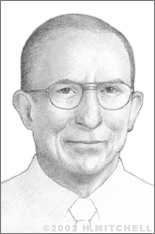Robert Ledley
Robert S. Ledley, inventor of the full-body Computer Tomography (CT) scanner, was born in 1926 in New York City. He studied dentistry, receiving a DDS from the New York College of Dentistry in 1948 and went on to earn an MA degree in theoretical physics from Columbia University in 1950.
He first worked for Washington D.C.’s National Bureau of Standards (now the National Institute of Standards and Technology) and later moved on to Johns Hopkins University, where he was a physicist and research analyst. From 1968 to 1970, he was a professor of Electrical Engineering in the School of Engineering and Applied Science at the George Washington University.
In 1970, Ledley joined the School of Medicine at Georgetown University Medical Center as a professor in the Department of Physiology and Biophysics. It was there, in 1973, that he developed the Automatic Computerized Transverse Axial (ACTA) x-ray scanner, which is known as the first whole-body CT machine.
The machine had a revolutionary impact on diagnostic medicine. It was able to generate visual models of internal organs that conventional x-ray machines were unable to produce. The three-dimensional reconstructions, created by transmitting X-ray beams through transverse axial slices of the body, allowed physicians to view soft tissue in the body with detail unlike any they had been able to see before. This improved the diagnosis of cancers, heart disease, bone disease, and other irregularities. The technology was also used in radiation therapy planning.
In 1974, Ledley became a professor in the Medical Center's Department of Radiology. In 1975, he was appointed Director of the Medical Computing and Biophysics Division. Ledley contributed to a number of areas within the field of diagnostic medicine and in other scientific areas as well. He patented the image processor (originally called the Texture Analysis Computer or TEXAC). He also wrote the first comprehensive textbook for engineers on digital computer engineering.
He developed computer systems for organizing the often very large volume of medical data required for precise diagnosis. He co-produced the first large-scale biotechnology databases, called Protein Information Resources (PIR), to organize all known protein and DNA sequences. He also invented the instrumentation and computer algorithms used for automated chromosome analysis for prenatal diagnosis of birth defects.
Over the course of his nearly 50-year career, Ledley earned more than 60 patents and numerous awards and honors, including induction into the National Inventor’s Hall of Fame in 1990. In 1997, he received the National Medal of Technology, awarded by President Clinton.
He passed away on July 24, 2012.


